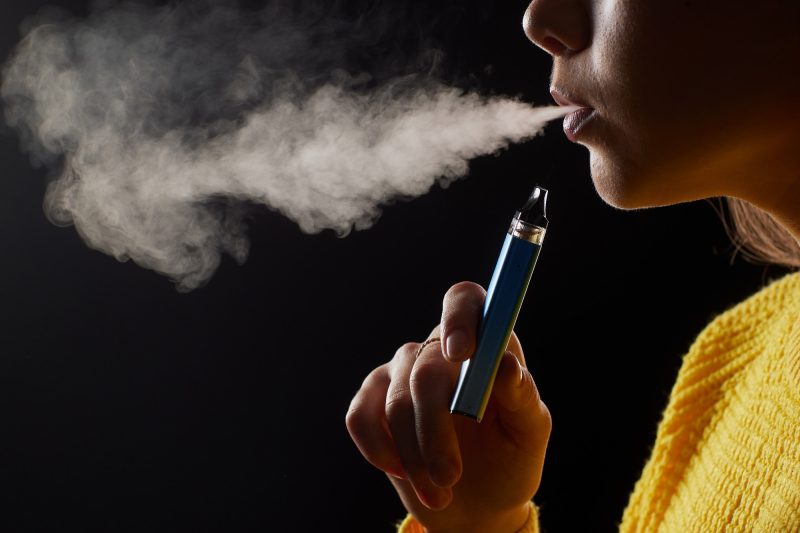Study reveals how salt-based nicotine and menthol flavors influence e-cigarette use in young adults

A recent study published in JAMA Network Open examines how salt-based nicotine formulations and menthol flavorings impact nicotine levels and the subjective experience of using e-cigarettes in young adults.
Study: E-Cigarette nicotine delivery among young adults by nicotine form, concentration, and flavor: a crossover randomized clinical trial. Image Credit: sergey kolesnokov / Shutterstock.com
E-cigarette use in young adults
Initially, e-cigarettes were marketed as a safer alternative to conventional cigarettes. However, young adults have become the primary consumers of e-cigarette products as compared to those of any other age group, which has led e-cigarettes to be the most commonly used tobacco product among young American adults.
In 2021, 20% of young adults were current vapers, whereas 10% of middle and high schoolers reported using e-cigarettes in 2023. The early use of e-cigarettes increases the risk of addiction, as daily vaping is currently reported by nearly 50% of young adults and 25% of teenagers in the United States.
Although the concentration of freebase nicotine in e-cigarettes is up to 90% lower than that in traditional cigarettes, the incorporation of various additives leads to the formation of nicotine salts and non-tobacco flavors that facilitate nicotine dependence. As a result, nicotine inhalation through e-cigarettes is smoother and easier, which increases their palatability for continuous use.
This innovation enabled the marketing of e-cigarettes with a nicotine concentration approximately three times higher than that of traditional freebase nicotine e-cigarettes, maximizing nicotine delivery.”
In conventional cigarettes, the presence of menthol reduces the harsh taste of nicotine while also increasing dependence. However, the effects of menthol in e-cigarettes remain unclear.
About the study
The current crossover randomized control trial (RCT) included 72 individuals between 21 and 25 years of age, all of whom reported e-cigarette usage. Study participants were provided with different salt-based or freebase nicotine products with 1% or 5% nicotine concentrations that were either menthol or tobacco-flavored.
In the first session, all study participants used their usual e-cigarette brand. In the following eight sessions, study participants were provided with any of the laboratory-formulated e-cigarette formulations. A five-minute 10-puff inhalation period was followed by 30 minutes of unrestricted vaping.
Blood samples were collected at baseline, five, 10, and 35 minutes during each vaping session for plasma analysis. A visual analog scale (VAS) was also used to assess the intensity of positive effects like desire, enjoyment, pleasure, and satisfaction during the vaping session.
Study participants were provided the Questionnaire of Smoking (QSU) to measure their urges and cravings for nicotine, as well as any withdrawal symptoms, during each vaping session. The duration, intensity, and frequency of puffs were recorded during each session.
What did the study show?
The mean participant age was 22, and nearly 60% of them were female. All study participants smoked at least one of the eight laboratory formulations.
Nicotine uptake
Salt-based nicotine e-cigarettes were associated with the highest nicotine uptake, especially with the 5% concentration. This led to mean plasma levels of 11.2 ng/mL and 17.2 ng/mL at five and 35 minutes, respectively.
Salt-based nicotine led to a 94% increase in plasma nicotine levels at five minutes, which subsequently decreased to 53% after 30 minutes of unrestricted vaping, as compared to freebase products. The 5% nicotine e-liquid increased plasma nicotine levels by about 50% and 65% at five and 35 minutes, respectively, compared to 1% nicotine.
Menthol flavoring increased plasma nicotine levels by 18% at 35 minutes, while no change was observed at five minutes.
Positive experience
Positive feelings were more likely with salt-based nicotine than with freebase e-cigarettes, with scores of 42.8 and 32, respectively. Similar findings were recorded with 1% and 5% nicotine products, with mean scores of 43.4 and 31.2, respectively. Menthol-flavored e-liquid was experienced more positively than tobacco-flavored products, at 43.2 and 31.5, respectively.
Tobacco-flavored 5% freebase nicotine had the least positive subjective outcomes, whereas menthol-flavored 5% nicotine salts had the highest subjective experiences for almost all positive measures.
Puff patterns
Puff intensity increased with nicotine salts and 1% concentration as compared to the freebase or 5% nicotine products.
The 1% e-liquid increased the total puff count by 47%, accompanied by a 20% increase in mean puff duration. Similar increases were observed in mean and total puff volumes and puff frequency.
Nicotine salt use led to 25% more puffs, whereas puff duration increased by 5% with approximately 10% higher mean and total puff volume. These effects were not attributed to menthol flavoring.
All laboratory e-liquids reduced nicotine urges and cravings, especially with the 5% concentration. The mean QSU-Desire score declined from 16.7 with the 1% formulation to 15.4 with 5% nicotine products.
Conclusions
The findings imply that salt-based nicotine formulations prevalent in the market may increase nicotine dependence among young adults already using e-cigarettes and warrant regulation.”
Current American vapes contain 5% nicotine as nicotine salts. Under standardized and unlimited vaping, nicotine levels in blood matched or exceeded those achieved by 10-12 puffs using an ordinary cigarette.
The positive experience and more intense puffing may increase the risk of addiction and abuse among young people using these products. Thus, regulators are advised to consider limiting the level of acidic additives and menthol flavoring present in e-cigarettes. This intervention could maintain the efficacy of e-cigarettes for traditional cigarette users looking to quit while also limiting their appeal to young adults.
Journal reference:
- Cho, Y. J., Mehta, T., Hinton, A., et al. (2024). E-Cigarette nicotine delivery among young adults by nicotine form, concentration, and flavor: a crossover randomized clinical trial. JAMA Network Open. doi:10.1001/jamanetworkopen.2024.26702.








